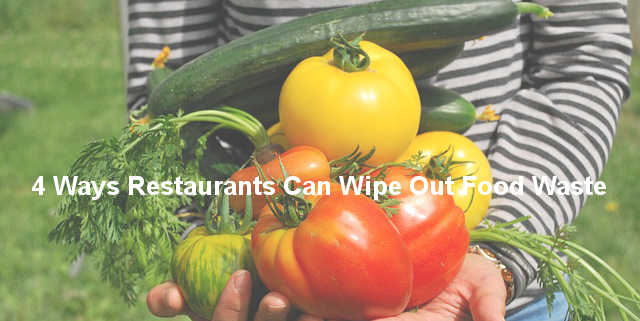4 Ways Restaurants Can Wipe Out Food Waste
Food waste is a big problem for restaurants. It means higher costs. It’s also a larger community problem as it compounds front page issues like sustainability and hunger. Cutting back food waste should be high priority for all restaurants. For one, it reduces operating costs while helping kitchens run more efficiently through improved oversight. Wiping out food waste also creates an opportunity to become an active and positive member of your local community. By becoming a leader in combating local issues, restaurant’s can gain followers from the glow of positive PR. It’s a win/win for restaurants and the community. Here are a few ways to avoid food waste.
Portion Control
A smart way to control food waste is to offer patrons a choice in serving sizes. The option allows customers to make a personal assessment of how much food they want to order. Offering a regular sized plate and a small plate can cut down waste because customers can adjust the amount of food being served to match their appetite or eating behavior. A smaller portion is a healthy option for guests that they will certainly appreciate. The benefits of offering different serving sizes is seen when practiced with wine sales. Uncorkd research shows that choice in serving size can increase sales. Creating multiple portion sizes also produces data points that a restaurant can track. As a restaurant operator, you could see what sized portions your restaurant sells consistently, and adjust your menu offerings accordingly.
Many restaurants already offer different sized lunch and dinner portions for a dish, so the prep and mis en place for multiple serving sizes is certainly achievable. Portion control can logistically lead to cutting cost and waste for auxiliary items like to-go containers and bags, as well.
Another portion control tip for restaurants that serve breakfast? STOP SERVING TOAST WITH EVERY ORDER. Most of that bread only makes a pit stop at tables before it’s tossed in the garbage. Not to mention all the bread that’s thrown out when a server accidentally burns it. Ask your guest if they would like toast or bread before bringing it table side.
Use Those Odds and Ends Creatively
Get creative with how you use ingredients. The chaff and cut off ends of produce can be used to make soups, stocks, banana breads, desserts and many other useful or salable items for a kitchen. Famed Italian chef Massimo Bottura recently wrote a piece for the Wall Street Journal on how he believes the next chapter for sustainable kitchens will be using salvaged food and food products normally reserved for the garbage can. The focus on salvaged food can help reduce the 550 million tons of discarded food from distributors, super markets, and consumers. As restaurants focus on more sustainable food sources, they will also take into account the use of that sustainable product.
Tracking Food Waste
Vigilant restaurants can impose a system to track food waste and find ways to reduce it. If you audit your food waste you can find where your biggest areas are and focus on opportunities to reduce it. Automated systems like LeanPath offer tools for operators to track and monitor their waste and define those spots where costs can be cut as well as waste. The biggest hurdle for successfully monitoring food waste is get your entire staff on board and serious about tracking waste. A way increase staff participation is to create incentive programs to track instances of waste in the same way you might create sales incentives for selling bottles of wine.
Food Recovery Programs
Fighting hunger can be more than donating the canned green beans collecting dust in your cupboard. A charitable way to curb your food waste is to donate items to hunger fighting organizations. Restaurants can become positive members of their community by participating in food recovery programs like the Green Chicago Restaurant Coalition or City Harvest in New York. These organizations “rescue” food from different points of the supply chain, including restaurants, and repurpose that food to help feed impoverished people. A quick internet search will find your local food recovery program. This is not only an act that can help save and improve lives, but it’s also a way to participate in and better your community. According to City Harvest’s website, they handle over 55 million pounds of food a year, and supply it to over 500 community food banks. It’s a great way to turn your cast off food into someone’s meal.
- 5 Fall Cocktails to Capture the Flavors of Autumn - September 26, 2018
- How Restaurants Can Ignore Sales and Increase Profits - May 9, 2018
- 2018 Spring Wine Trends - April 18, 2018









